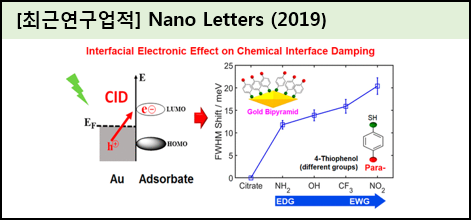|
Title |
Tuning Chemical Interface Damping: Interfacial Electronic Effects of Adsorbate Molecules and Sharp Tips of Single Gold Bipyramids |
|
Author list |
Lee, So Young; Tsalu, Philippe Vuka; Kim, Geun Wan; Seo, Min Jung; Hong, Jong Wook; Ha, Ji Won |
|
Publication date |
2019/04 |
|
Citation information |
Nano Letters, 19, 2568 (2019) |
|
DOI |
10.1021/acs.nanolett.9b00338 |
|
Graphical Abstract |

|
|
Abstract |
The optimization of the localized surface plasmon resonance (LSPR)-decaying channels of hot-electrons is essential for efficient optical and photochemical processes. Understanding and having the ability to control chemical interface damping (CID) channel contributions will bring about new possibilities for tuning the efficiency of plasmonic hot-electron energy transfer in artificial devices. In this scanning electron microscopy-correlated dark-field scattering study, the CID was controlled by focusing on the electronic nature of disubstituted benzene rings acting as adsorbates, as well as the effects of sharp tips on gold bipyramids (AuBPs) with similar aspect ratios to those of gold nanorods. The results showed that the sharp tips on single AuBPs, as well as the electronic effects of the adsorbate molecules, increase the interfacial contact between the nanoparticles and adsorbate molecules. Electron withdrawing groups (EWGs) on the adsorbates induce larger homogeneous LSPR line widths compared to those of electron donating groups (EDGs). Depending on the location (ortho, meta, and para) of the EDG, the effect of benzene rings with an EDG, which was considered to be induced by sulfur atoms bound to the nanoparticle surface, is weakened by the back transfer of electrons facilitated by the difference in the availability of the electrons of the EDG. Therefore, this study reports that the CID in the LSPR total decay channels can be tuned by controlling the electron withdrawing and electron donating features of adsorbate molecules with the surface topology of metal.
| |

